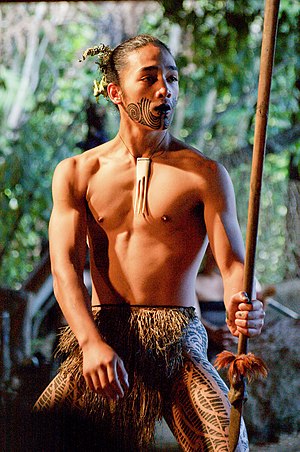![Young Maori man. Apparently (based on Flickr t... Young Maori man. Apparently (based on Flickr t...]()
- Image via Wikipedia
Rare mutations that knock-out the function of monoamine oxidase a gene have long been known to give rise to developmental changes that increase the propensity of males to engage in aggressive behavior. The effects of so-called natural variants – that may slightly reduce or increase the amount of activity of the MAOA protein – can be harder to understand since they are less-definitive and perhaps more easily masked or influenced by the environment and developmental mileu. Nevertheless, the role of natural, common variation in the maoa gene and its relation to aggressive behavior in boys remains of interest – witness a news report today, “‘Warrior Gene’ Linked To Gang Membership, Weapon Use: FSU Study”.
Rather than debate the validity and merits of such sensational headlines, it may be more productive to understand how & why naturally occurring genetic variation might influence the development of the brain in a way that makes it more difficult for adolescents and adults to control their aggressive impulses. Clearly, healthy males have a predisposition to act out moreso than females, which – while at odds with our modern societal norms – comes along with our evolutionary legacy and phylogenetic relationship to other primates and mammals where male aggression is the rule. In this sense, the really exciting story, is not whether there is something amiss with schoolboys who carry certain genetic variants of maoa, but how such variants work over the course of normal brain development and why, in terms of our own evolutionary history, we carry such variants.
That male-male aggression can be a means to differentiate male fitness and – via sexual selection in females – reduce mutational load, has been widely shown across the sexually-reproducing biome. Thus, while variants such as the high expression 4-repeat VNTR in maoa have likely been helpful, rather than hurtful, in the establishment and survival of our noble species, it may be a difficult task to prove such a proposition. As Stephen Jay Gould once wrote, “Thus, we are presented with unproved and unprovable speculations about the adaptive and genetic basis of specific human behaviors: why some (or all) people are aggressive, xenophobic, religious, acquisitive, or homosexual” (Our Natural Place, p. 243). Nevertheless, we may learn a bit about ourselves as we relate genetic variation to both cognitive science and to rigorous phylogenetic analysis.
One great example of a recent paper that covers the link from genes to cognition is, “MAO A VNTR polymorphism and variation in human morphology: a VBM study” by Cerasa et al., [PMID: 18596609]. Here the team investigates the structure of the human male brain using a method known as voxel-based-morphometry (VBM) that allowed them to ask where in the brain one might observe grey-matter changes that are correlated to genotype? After an analysis of 33 high-maoa-expressing males vs. 26 low-expressing males, the team found that only in the orbitofrontal cortex were such associations significant. This, as noted by the team, is of interest, since the orbitofrontal cortex is an area of the brain that is known to regulate impulsivity. In this study, the high-expressing males had lower levels of grey matter in the orbitofrontal cortex, a result that is in-line with a previous finding – however it remains somewhat out of trend with earlier findings showing that smaller orbitofrontal cortex volumes (without respect to genotype) are associated with higher impulsivity and findings that show that boys with the high-expression form of MAOA were less likely to engage in aggressive behavior.
Clearly, this little bit of the genome containing the MAOA-VNTR has a complex – but interesting story to tell. The gene does not seem to show any evidence for recent positive selection, so perhaps the role of maoa and its effects on aggression were worked out long before our lineage came along. Indeed, now we must learn to bear our genetic legacy proudly and humanely. Good luck!


![Reblog this post [with Zemanta]](http://img.zemanta.com/reblog_c.png?x-id=1c187156-527b-465a-9f10-7b6243d29f40)



















